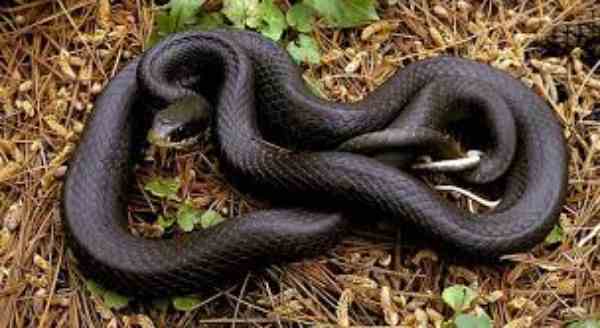The chicken snake, despite its name, doesn’t exclusively eat chicken. These nonvenomous creatures prefer smaller animals like birds and rats. It’s fascinating to know that these snakes are native to North America and can be found near water and forests.
Table of Contents
Typically, their colouration can range from brown to grey with black stripes running down their backs. It’s interesting to note that chicken snakes can grow up to seven feet in length and will choke their prey before consumption. If they sense danger, these snakes will coil and attack in defence. While they might give off a creepy vibe, there’s no need to fear these harmless creatures.
Chicken Snake Scientific Name
This snake, scientifically named Spilotes pullatus, has a unique backstory to its name. The name Spilotes comes from the Greek word “spilos” which means spotted or stained. This is fitting for the snake, as they often have a distinctive spotted pattern on their skin. The second part of the name, pullatus, is derived from Latin, and means “wearing dark clothes”. This description is also fitting for the snake, as they often have a dark-coloured underside.
Classification of Chicken Snakes:
These snakes encompass a diverse group of snake species, comprising five distinct members:
#1 Eastern Rat Snake:
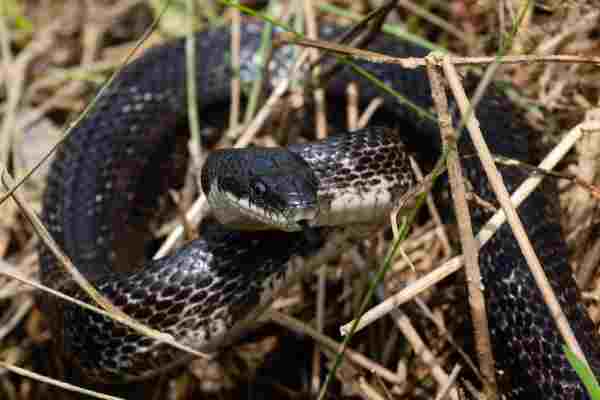
The eastern rat snake is the largest of its species, capable of reaching an impressive length of seven feet! Its sleek black scales and contrasting creamy white underbelly make for a striking sight.
Found from Connecticut to South Carolina, these snakes can often be spotted sunning themselves in fields or basking on fence posts. Despite their formidable size, these snakes are excellent climbers, and can often be seen scaling trees or walls in pursuit of prey.
#2 Corn Snake:
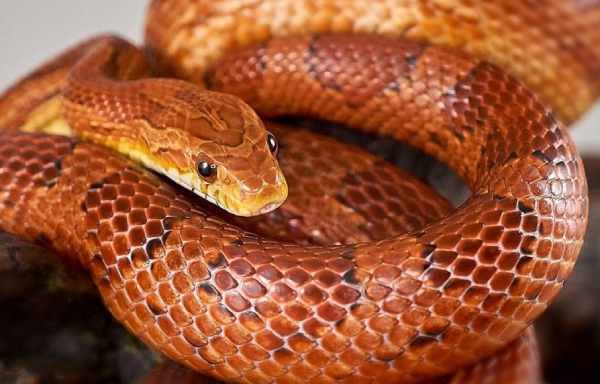
These serpents are slender and petite, measuring in at just a few feet long. But don’t let their size fool you – they’re an impressive species. Corn snakes come in a range of hues, including hues of orange, reddish brown, and grey, and their skin is beautifully patterned with speckles. One identifying characteristic of the corn snake is the stripe running from under the eye to the body. Moreover, these amazing animals are non-venomous, making them a safe and easy-care choice for pet lovers.
#3 Black Rat Snake:
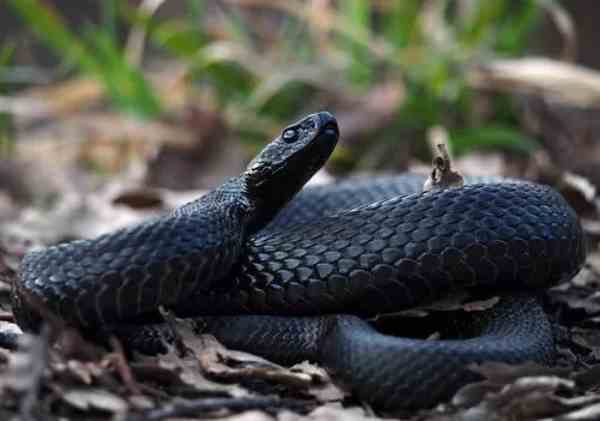
The black and dull back of these non-venomous species is contrasted by the bright and white scales on their belly, making them a unique sight to behold. With a maximum growth limit of six feet and a smaller body compared to their head, these fascinating creatures can be found in a vast number of U.S. states, spanning from the Midwest to the East. Their distinct appearance, combined with their wide distribution, makes them a popular sight for nature lovers across the country.
#4 Gray Rat Snake:
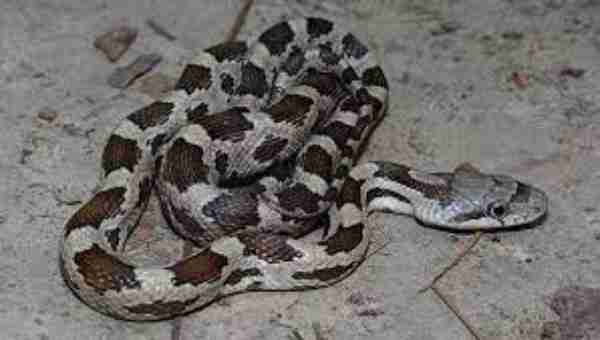
Grey rat snakes are fascinating creatures that can reach incredible lengths. Despite their impressive size, these serpents are known for their gentle nature and lack of aggression towards humans. With dark grey markings on their back and a checkerboard pattern on their belly, grey rat snakes are truly a sight to behold.
Their slender head and thick body allow them to gracefully weave in and out of tight spaces. These snakes are found throughout the Midwest and eastern United States, making them a common sighting for many nature enthusiasts.
#5 Northern Pine Snake:
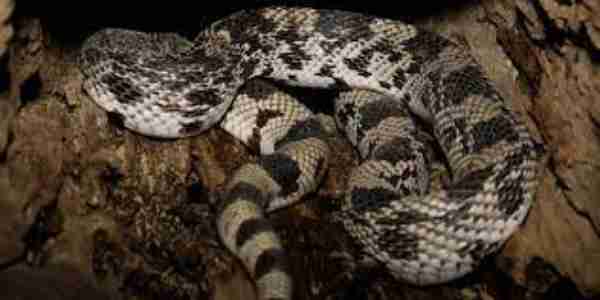
Northern Pine snakes are a fascinating species that many people may not be familiar with. Although they may look intimidating with their large size, reaching up to eight feet in length, they are actually non-venomous. Their black body splotches range in colour from grey-brown to rusty-brown, and their belly can be cream, yellow, or tan. These snakes have a distinctive tortoise-like appearance, with their bodies being larger than their heads.
Unique Features of These Snakes:
Have you ever come face to face with a snake that seemed to go on forever? This particular species is known for its extreme length and thin build. Its striking appearance includes a black and yellow head with unique diagonal, net, or cross-band markings.
As you move down the body, you’ll notice rows of dorsal scales and a belly containing numerous scales. But, what stands out the most are its big eyes and wide pupils, similar to many other colubrids. Encounter this snake in its natural habitat and you’ll be in awe of its beauty and elegance.
Physical Appearance of These Snakes:
The fascinating snake species usually have uniformly brown or tan-coloured bodies. However, what makes them stand out are the light colour spots that decorate their skin similar to chicken feathers, and the prominent dark bands running down their backs and around their eyes.
The distinguishing feature makes it easier to identify them from other local snake species. What’s more, despite the bands and spots, and are relatively harmless to humans because of their small teeth.
Habitat:
Chicken snakes are certainly an impressive creature to encounter. Their ability to traverse both the ground and the trees is a testament to their adaptability. While they can be found in a variety of locations across North America, it’s interesting to note that they can also be found in southern Mexico, Central America, northern and central South America, and Trinidad and Tobago.
Given their inclination towards marshes, swamps, and woodlands, it’s no surprise that they are often discovered on farms as well. In fact, in some situations, these snakes may even make their way into homes, as they are known to have a fondness for rodents, which are plentiful in such situations.
Diet:
Chicken snakes are known for their highly voracious appetite. These predators will feast on almost anything that comes their way, ranging from small rodents and birds to carrion, frogs, eggs and lizards. While they may prefer to hunt smaller prey, there have also been reports of chicken snakes taking down unsuspecting chickens.
Thanks to their impressive climbing skills, these snakes are also able to navigate quickly between trees in search of meals. This makes it easy for them to steal bird eggs from nests, adding yet another potential food item to their already expansive menu.
Reproduction and Mating:
As the temperatures rise and flowers start to bloom, it’s not just humans that are feeling the excitement of spring. For snakes, this season marks the beginning of their breeding season and an opportunity for courtship rituals to begin. After the male follows the female in a dance-like display, mating takes place and the female lays her eggs in a secluded area.
From there, it’s a waiting game of 73 to 76 days until the hatchlings emerge from their shells. While these baby snakes are able to take care of themselves, they are still vulnerable to predators until they are able to grow and thrive in the wild.
It’s fascinating to think that something as small as a chicken snake, which starts off at just 8 to 12 inches at birth, has the ability to grow and develop into a creature that commands respect in the animal kingdom.
Chicken Snake Behavior:
Chicken snakes may be isolated and territorial animals, but they know how to protect themselves. If they feel threatened, they won’t hesitate to escape. Their clever tactics include falling from trees and hiding from sight. With a notable swelling of their neck, they look like cobras – a seemingly dangerous animal to cross.
Due to their, “night owl” habits, chicken snakes are mainly active at night, while sleeping in holes or rocks during the day. While also imitating the intimidating rattle of a rattlesnake, chicken snakes will resort to attacking if a predator does not back down.
What Time of Day is Chicken Snakes Most Active?
If you have a chicken snake problem, you might be surprised to learn that these slithery creatures are actually most active when the weather is cool. They’re nocturnal creatures by nature, so they like to come out under the cover of darkness to look for food and explore their surroundings. However, don’t be surprised if you spot one in the early morning hours too – they’re known to be a bit of a morning bird. When they’re not out hunting, chicken snakes like to find a quiet, dark place to cool off and relax.
Can Chicken Snakes Climb Walls and Trees?
As it turns out, some snake species are excellent climbers. They can scale both trees and walls with relative ease. However, unlike insects, snakes cannot simply stick to walls. Instead, they rely on a strong base and sufficient grip to make their way up.
Nonetheless, this does not stop them from pursuing their prey up into the trees. Indeed, some snakes are skilled bird hunters and will use their unique ability to climb to pursue their targets. In order to do so, these particular snake species have evolved special keeled ventral scales that help them grip surfaces as they climb.

Are Chicken Snakes Poisonous?
If you’re out exploring nature and come across a chicken snake, don’t be alarmed. These creatures are non-venomous so you won’t need to worry about their bite. However, due to their diet of other poisonous animals, chicken snakes may still carry some poison that could be harmful to humans.
It’s best to avoid interacting with them if possible. It’s always fascinating to encounter wild animals on our adventures, and while chicken snakes might not be dangerous to humans, it’s important to respect their space and admire them from a safe distance.
What Risks Do Chicken Snakes Pose?
While it’s true that chicken snakes don’t carry any toxic venom, that doesn’t mean they aren’t a threat. These constrictors use their powerful bodies to encircle and suffocate their prey, and if a small child or pet happens to be in the wrong place at the wrong time, they could easily become a target.
But chicken snakes will also attack if they feel threatened, and their bites can leave a painful open wound that should be cleaned and treated just like any other injury. So while they may not be deadly, it’s important to remember that these seemingly harmless creatures can still cause harm if provoked.
How to Do Chicken Snakes Attack?
Chicken snakes, also known as rat snakes, are expert hunters that use their keen sense of smell to find prey. These snakes are quick to attack once they locate their meal and will use constriction to suffocate their victim. It is a gruesome sight, but effective nonetheless.
By squeezing its prey to death, the snake ensures that it won’t get away and has an easy meal to feast on. Chicken snakes are skilled predators, and their hunting behaviour is an astounding display of nature’s power.
What Draws Snakes to Your Place?
Chicken snakes are fascinating reptiles that are known for their love of insects, rats, and mice. If you happen to be a homeowner, it’s important to take precautions to avoid inviting these sneaky creatures inside. One way to keep your home free of chicken snakes is to avoid leaving pet food outside. Rodents tend to congregate near an accessible food source, and this means that pet food left outdoors can quickly become a magnet for these critters.
As a result, chicken snakes may become attracted to your yard or even find their way into your home. If you want to keep these slinky reptiles at bay, it’s certainly worth keeping your pets indoors and ensuring their food is stored away safely. By taking these simple steps, you can help keep your home free of unwanted guests and enjoy a pet-friendly environment without fear of creepy crawlies.
Tips and Tricks for Managing Chicken Snakes Safely and Effectively
Encountering a chicken snake on your property may raise concerns, but it’s important to approach the situation with caution. These snakes play a beneficial role in controlling the population of mice and small rodents. However, they can pose potential risks to the safety of your family and pets. Here are some steps you can take to address the presence of chicken snakes:
Seek Professional Assistance:
It is advisable to contact an expert in snake handling when you spot a chicken snake. These professionals have the necessary experience and knowledge to safely remove the snake from your premises and relocate it to a more suitable habitat.
Exercise Caution if Handling the Snake:
If you have prior experience with handling snakes, you may choose to remove the chicken snake yourself. However, extreme caution is essential. Wear appropriate safety gear, such as gloves, and use a long stick or tool to maintain a safe distance. Keep in mind that chicken snakes can become aggressive if they feel trapped, so be prepared for any potential biting behaviour.
Utilize Snake-Repelling Smells:
Certain scents are known to repel snakes. Options such as smoke, lime, onions, garlic, cinnamon, and cloves can be used in the form of oils or sprays. Alternatively, planting fragrant herbs or flowers with these scents in your garden can help deter snakes from approaching.
Employ a Garden Hose:
Using a garden hose can be an effective method to scare snakes away from your yard. Direct a constant stream of water towards the snake, and it will likely retreat swiftly. Consider installing a perch pole in your yard to attract natural predators of snakes, such as eagles or owls, which can help prevent chicken snakes from entering your property.
Harness the Power of Eggshells:
Another practical approach to deterring chicken snakes is by utilizing eggshells. Scatter a layer of coarse, pointed mulch on your garden beds, creating an unwelcoming texture for the snakes. Natural elements like holly leaves, sharp rocks, or pine cones can also serve the same purpose—creating surfaces that discourage snakes from slithering through.
By implementing these methods, you can manage the presence of chicken snakes in a safe and humane manner while ensuring the well-being of your household.
The Truth About Chicken Snakes and Their Appetite
Chicken snakes, while not a single species, comprise five distinct sub-species of non-venomous colubrid snakes. These snakes can be found across various regions in North America. Interestingly, all of them share a common trait: a preference for young chicks and chicken eggs. By observing their habitat, you can easily identify them.
Size and Non-Venomous Nature of Chicken Snakes
Growing to over 7 feet in length, chicken snakes exhibit remarkable physical characteristics. Despite their size, these snakes pose no venomous threat to humans. Instead, they fall into the category of non-venomous constrictors. Their modus operandi involves squeezing their prey to death before consumption. In some instances, they prove helpful to farmers by preying on rats and other small rodents that can damage crops.
Understanding Chicken Snakes as Pets
While some individuals choose to keep chicken snakes as pets due to their non-venomous nature, it’s important to exercise caution and provide appropriate care. It is generally advised not to house them with other pets. Additionally, observing these snakes in their natural habitat can be equally fascinating and entertaining.
The Benefits of Chicken Snakes for Farmers
Despite their reputation, snakes can play a beneficial role on farms. Consequently, many farmers choose not to eliminate them from their crops. Instead, they allow these snakes to roam freely, taking advantage of their predation on small rodents like rats. Some farmers even strategically place chickens in their fields to attract chicken snakes, forming a natural pest control method.
Chicken Snakes vs. Other Snakes: The Contrasts
When comparing chicken snakes to other snake species, notable differences emerge:
Chicken Snake vs. Rat Snake:
Chicken snakes fall under the broader category of rat snakes. They are also referred to as tiger rat snakes or yellow rat snakes. Nevertheless, they exhibit unique characteristics that set them apart from other rat snakes, including the potential for hybridization.
Chicken Snake vs. Copperhead:
Chicken snakes differ significantly from copperheads in terms of size and venomous properties. While chicken snakes can grow up to 96 inches in length, copperheads typically reach only 20 to 37 inches. Copperheads possess distinctive coppery heads and are venomous, whereas chicken snakes rely on constriction and lack venom.
Chicken Snake vs. Coachwhip Snake:
Chicken snakes and coachwhip snakes can be distinguished by their physical appearance and preferred habitats. Chicken snakes feature four stripes along their bodies, while coachwhip snakes have long, thin tails tapering into blackheads. Furthermore, chicken snakes are excellent swimmers and tend to reside near water, whereas coachwhip snakes thrive in dry environments and prioritize ground hunting over swimming.
Identifying Non-Venomous Chicken Snakes
Differentiating venomous from non-venomous snakes can be challenging for some individuals. One simple method involves observing the shape of a snake’s pupils. Vertical pupils resembling those of a cat typically indicate a venomous snake. On the other hand, round pupils resembling human eyes suggest a non-venomous snake. However, it is essential to remember that even non-venomous snakes can bite if threatened, and their bites can still be painful and alarming.
FAQs
Which is known as a chicken snake?
It is a non-venomous species that can grow up to six feet long. With its slender body, glossy scales, and yellowish-brown stripes, this snake is often mistaken for a dangerous species, but it is harmless to humans and actually plays an important role in controlling rodent populations. Despite its name, the chicken snake does not exclusively hunt chickens but will eat a variety of small mammals, birds, and even other snakes.
What is the lifespan of a chicken snake?
On average, they can live up to 20 years in the wild, but some captive specimens have been known to live as long as 25 years.
What kind of snake can eat a chicken?
Many people are surprised to learn that there are several types of snakes that are capable of consuming a chicken. Generally, it’s the larger species of snakes that pose the biggest threat to our feathered friends. For example, the Burmese Python is known to grow to an impressive length of over 20 feet and has a reputation for taking down large prey such as pigs and deer. Similarly, the King Cobra, notorious for its deadly venom, has also been known to feast on chickens.
How do I identify a rat snake?
Rat snakes are commonly found across North America and are a nonvenomous species, so they may be less of a threat than other snakes you might encounter. One way to spot a rat snake is by its signature black and white checkered pattern on its back, which is similar to a checkerboard. They also have a sleek and slender body and can grow up to 8 feet in length. Rat snakes are known for being excellent climbers and are commonly found in trees and shrubs.
Final Words
In conclusion, chicken snakes encompass fascinating aspects that make them intriguing subjects of study. Their non-venomous nature, intriguing behaviours, and agricultural benefits contribute to their allure. Whether admired in their natural habitats or kept as pets, proper care and precautions should always be taken into consideration.
Reference:
- https://www.britannica.com/animal/chicken-snake
- https://srelherp.uga.edu/snakes/elaobs.htm
- https://www.freedomrangerhatchery.com/blog/how-to-keep-snakes-out-of-a-chicken-coop/

Jeevan Kodiyan
An animal enthusiast with an interest in zoology, studying the behavior and activities of animals in the wild habitat. I work on research projects related to species conservation and endangered species protection. I also leverage zoology to become an educator, educating others about the importance of protecting our natural environment and the beauty of animals in their natural habitats.

